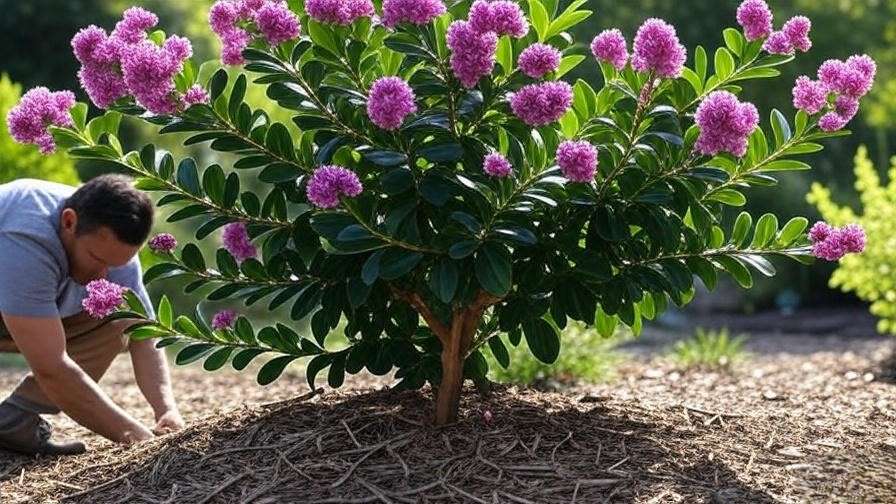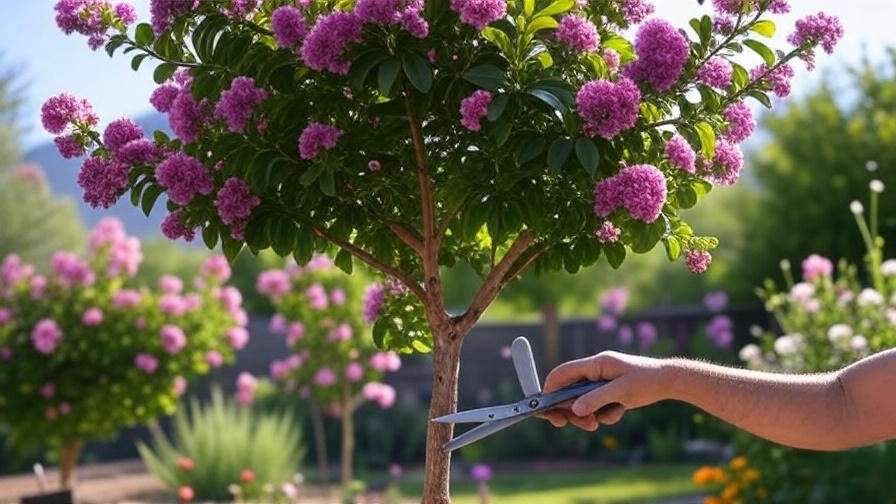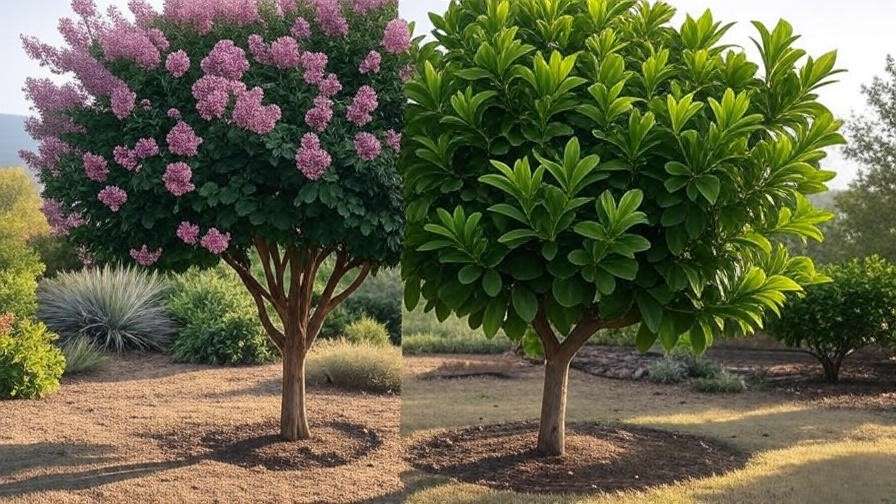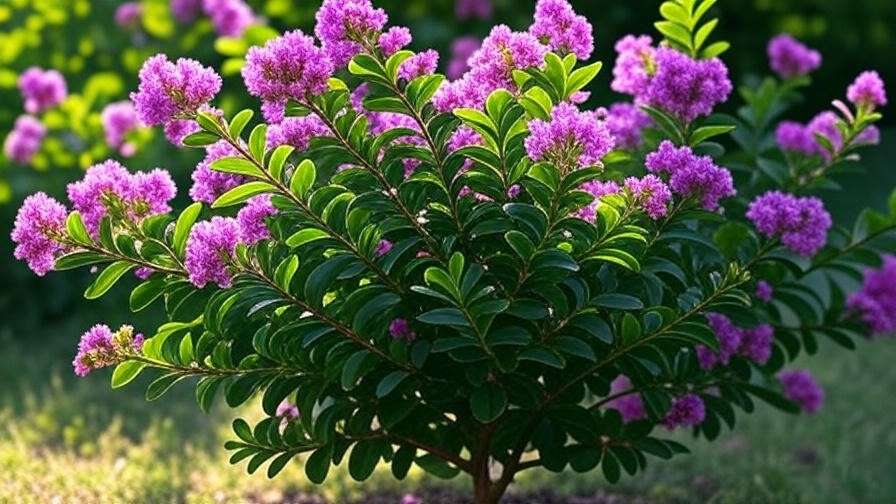Picture your garden bursting with vibrant purple-pink blooms, even in the smallest of spaces. The Zuni Crape Myrtle tree, a compact and stunning hybrid, transforms any landscape with its dazzling flowers and glossy foliage. Whether you’re a seasoned gardener or a beginner, this guide will equip you with expert tips to grow and maintain a thriving Zuni Crape Myrtle. From planting to pruning, we’ll cover everything you need to ensure your tree flourishes, addressing common challenges and unlocking its full potential. Backed by decades of horticultural expertise from sources like the U.S. National Arboretum, this comprehensive guide promises actionable advice for stunning results. Ready to create a showstopping garden? Let’s dive in! 🌺
1. Understanding the Zuni Crape Myrtle Tree 🌳
1.1 What Makes the Zuni Crape Myrtle Special? ✨
The Zuni Crape Myrtle (Lagerstroemia indica ‘Zuni’) is a standout in the world of ornamental trees. Developed by the U.S. National Arboretum, this hybrid boasts a compact size, growing to just 4-6 feet tall and wide, making it perfect for small gardens, patios, or urban landscapes. Its vibrant purple-pink blooms, which appear from summer to early fall, create a striking display, while its glossy, dark green leaves turn brilliant shades of orange and red in autumn. Unlike larger crape myrtles, the Zuni’s manageable size and resistance to common issues like powdery mildew make it a favorite among gardeners. Its exfoliating bark adds year-round visual interest, peeling to reveal a smooth, mottled texture.
1.2 Why Choose the Zuni Crape Myrtle? 🌼
The Zuni Crape Myrtle is a versatile choice for gardeners seeking beauty with minimal effort. Its long blooming season—up to 120 days—ensures months of color. Hardy in USDA zones 6-9, it thrives in diverse climates, from the humid South to drier regions. Its drought tolerance and low maintenance needs make it ideal for busy homeowners or those new to tree care. Whether used as a focal point, a border plant, or in a container, the Zuni adapts effortlessly. Plus, its resistance to deer and many pests adds to its appeal for low-maintenance landscapes. For anyone looking to elevate their garden with vibrant, reliable beauty, the Zuni Crape Myrtle is a top contender
2. Planting Your Zuni Crape Myrtle: Getting Started Right 🌱
2.1 Choosing the Perfect Location 📍
Location is critical for a thriving Zuni Crape Myrtle. This tree demands full sun—6+ hours of direct sunlight daily—to produce its signature vibrant blooms. Insufficient light can lead to sparse flowering, so choose an open spot away from tall structures or shade-casting trees. Soil should be well-drained, as Zuni Crape Myrtles dislike “wet feet.” Aim for slightly acidic to neutral soil (pH 5.5-7.5); a soil test can confirm suitability. If drainage is poor, consider raised beds or amending with compost. Space is another factor—allow 4-6 feet for the tree to reach its mature size without crowding. Avoid planting near foundations or sidewalks, as roots may cause minor disruption over time.
2.2 When and How to Plant 🕰️
Timing matters for successful planting. Early spring or fall is ideal, allowing roots to establish before extreme heat or cold. To plant, dig a hole twice as wide and as deep as the root ball. Mix native soil with organic compost to improve drainage and nutrient content. Place the tree so the root flare sits slightly above ground level, then backfill and tamp gently. Water thoroughly to settle the soil. Expert Tip: Apply a 2-3 inch layer of organic mulch (like bark or wood chips) around the base, keeping it 2 inches from the trunk to prevent rot. This retains moisture and suppresses weeds.

2.3 Container Planting for Small Spaces 🪴
For urban gardeners or those with limited space, Zuni Crape Myrtles thrive in containers. Choose a pot at least 18-24 inches in diameter with excellent drainage holes. Use a high-quality potting mix blended with perlite or sand to ensure drainage. Place the container in a sunny spot and rotate it occasionally for even growth. Water more frequently than in-ground trees, as pots dry out faster. Repot every 2-3 years to refresh soil nutrients and accommodate root growth. Containers allow flexibility—move your Zuni to a sheltered spot in colder climates during winter.

3. Essential Care Tips for a Thriving Zuni Crape Myrtle 🌞
3.1 Watering Needs 💧
Proper watering is key to a healthy Zuni Crape Myrtle, especially in its first year. For newly planted trees, water deeply (1-2 gallons) every 3-4 days for the first 2-3 months, adjusting based on rainfall. Once established, reduce to weekly deep watering during dry spells. Aim for moist, not soggy, soil—overwatering can cause root rot, while underwatering may stress the tree, reducing blooms. Check for signs: yellowing leaves often indicate overwatering, while wilting or crispy leaves suggest underwatering. In hot climates, mulch helps retain moisture. Always water at the base, not overhead, to keep foliage dry and prevent fungal issues.
3.2 Fertilizing for Vibrant Blooms 🌼
To boost growth and flowering, fertilize your Zuni Crape Myrtle with a balanced, slow-release fertilizer (e.g., 10-10-10) or a bloom-boosting formula high in phosphorus (e.g., 5-10-5). Apply in early spring as new growth begins, and again in mid-summer for sustained blooms. Spread fertilizer evenly around the drip line (the area under the canopy), avoiding direct contact with the trunk. Water thoroughly after application. Expert Insight: Over-fertilizing, especially with nitrogen-heavy formulas, can lead to lush foliage but fewer flowers. A soil test can guide precise nutrient needs, ensuring optimal results without waste.
3.3 Pruning for Shape and Health ✂️
Pruning keeps your Zuni Crape Myrtle healthy and shapely. The best time is late winter or early spring, before new growth starts. Remove suckers (shoots at the base), dead or damaged wood, and crossing branches to improve air circulation and reduce disease risk. Shape the tree to maintain its natural form—avoid “crape murder” (severe topping), which weakens the tree and produces spindly growth. Use clean, sharp pruners to make angled cuts just above outward-facing buds. For a polished look, thin out crowded branches to highlight the tree’s attractive bark. Regular pruning encourages vibrant blooms and maintains the compact size ideal for small spaces.

4. Troubleshooting Common Zuni Crape Myrtle Issues 🐞
4.1 Pests and Diseases 🦟
While the Zuni Crape Myrtle is relatively hardy, it can face pest and disease challenges. Common pests include aphids, which suck sap and leave sticky residue, spider mites that cause stippled leaves, and Japanese beetles that chew foliage. For aphids and mites, a strong blast of water or insecticidal soap often suffices. Japanese beetles may require hand-picking or neem oil applications. Diseases like powdery mildew, appearing as white patches on leaves, thrive in humid conditions. Improve air circulation through proper pruning and apply fungicides (like sulfur-based products) if needed. Leaf spot, another concern, causes dark spots and premature leaf drop. Remove affected leaves and avoid overhead watering. Expert Tip: Opt for eco-friendly solutions like neem oil to protect beneficial insects and maintain a healthy garden ecosystem. Regular monitoring catches issues early, preventing escalation.

4.2 Environmental Challenges 🌪️
Poor blooming is a frequent complaint with Zuni Crape Myrtles, often due to insufficient sunlight, improper pruning, or nutrient imbalances. Ensure your tree gets 6+ hours of direct sun daily and avoid heavy pruning that removes flower buds. If blooms are sparse, test soil to check for phosphorus deficiency and adjust fertilization. In colder climates (USDA zone 6), winter damage can stress the tree. Protect roots with a 3-4 inch layer of mulch and wrap the trunk with burlap in harsh winters. Excessive shade or poor drainage can also stunt growth—relocate container plants or amend soil for in-ground trees. By addressing these environmental factors, you can restore your Zuni’s vigor and ensure a spectacular floral display
5. Seasonal Care Calendar for Zuni Crape Myrtle 📅
Caring for your Zuni Crape Myrtle varies by season to keep it healthy year-round. In spring, focus on fertilizing with a balanced formula and pruning to remove winter damage. Check for new growth and ensure adequate watering as temperatures rise. During summer, maintain consistent deep watering, especially in hot, dry periods, and deadhead spent blooms to encourage reblooming. Monitor for pests like aphids and treat promptly. In fall, reduce watering as the tree prepares for dormancy, and enjoy its vibrant foliage colors. Apply a final layer of mulch to insulate roots. In winter, protect trees in colder zones with mulch or burlap, and avoid pruning until late winter to prevent frost damage.

Downloadable Seasonal Care Checklist:
| Season | Task | Notes |
|---|---|---|
| Spring | Fertilize, prune, water | Use 10-10-10 fertilizer; remove dead wood |
| Summer | Water, deadhead, pest control | Deep water weekly; use neem oil for pests |
| Fall | Reduce watering, mulch | Prepare for dormancy; add 3-4 inches mulch |
| Winter | Protect roots, minimal care | Wrap trunk in zone 6; avoid pruning |
This structured approach ensures your Zuni thrives through every season.
6. Design Ideas: Incorporating Zuni Crape Myrtle in Your Landscape 🏡
6.1 Garden Design Inspiration 🌸
The Zuni Crape Myrtle’s compact size and vibrant blooms make it a versatile addition to any garden. Use it as a focal point in small spaces, such as a courtyard or front yard, where its purple-pink flowers draw the eye. Pair it with low-growing perennials like lavender, salvia, or coreopsis for a colorful, low-maintenance bed. Its autumn foliage adds seasonal interest, complementing ornamental grasses or evergreen shrubs. For a cohesive look, plant in odd-numbered groups (e.g., three or five trees) to create a natural flow in larger landscapes. The Zuni’s exfoliating bark also makes it a standout in winter, especially when backlit by low-angle sunlight.

6.2 Creative Uses in Landscaping 🎨
Beyond traditional garden beds, Zuni Crape Myrtles shine in creative applications. Use them as border hedges along walkways or property lines for a vibrant, low-growing barrier. In containers, they enhance patios or balconies, bringing color to urban spaces. For mixed shrub beds, combine with hydrangeas or roses for contrasting textures. Example: A homeowner in Austin, Texas, transformed a small front yard by planting three Zuni Crape Myrtles in a triangular formation, surrounded by native wildflowers. The result was a pollinator-friendly, drought-tolerant display that boosted curb appeal. Strategic placement near outdoor seating areas maximizes enjoyment of the tree’s blooms and fragrance, creating a welcoming atmosphere
7. Frequently Asked Questions (FAQs) ❓
- Why isn’t my Zuni Crape Myrtle blooming?
Sparse blooms often stem from insufficient sunlight (less than 6 hours daily), over-pruning, or nutrient deficiencies. Ensure full sun exposure, prune lightly in late winter, and fertilize with a phosphorus-rich formula. - Can I grow a Zuni Crape Myrtle in a cold climate?
Yes, it’s hardy in USDA zones 6-9. In zone 6, protect roots with mulch and wrap the trunk during harsh winters to prevent frost damage. - How do I prevent powdery mildew on my tree?
Improve air circulation through proper pruning, avoid overhead watering, and apply organic fungicides like neem oil if mildew appears. - Is the Zuni Crape Myrtle deer-resistant?
Generally, yes. Deer tend to avoid crape myrtles due to their tough foliage, but in high-pressure areas, consider protective netting for young trees.
These FAQs address common concerns, boosting search visibility and reader engagement.
8. Conclusion: Enjoy Your Vibrant Zuni Crape Myrtle! 🎉
Growing a Zuni Crape Myrtle tree is a rewarding journey, offering vibrant blooms, stunning foliage, and year-round beauty with minimal effort. By choosing the right location, providing consistent care, and addressing challenges like pests or poor blooming, you’ll enjoy a thriving tree that elevates your landscape. Experiment with creative design ideas, from container displays to colorful garden beds, to make your Zuni the star of your outdoor space. For further inspiration, share photos of your Zuni Crape Myrtle on social media or comment below with your questions! Backed by trusted sources like the U.S. National Arboretum and university extension programs, this guide ensures your success. Happy gardening! 🌟













